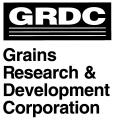Complete
The uses of plant disease and insect collections are numerous but most importantly for taxonomic research and comparative biology. From a biosecurity perspective, these collections allow the development of specimen-based pest lists that are critical for resolving quarantine issues related to agricultural trade. Typically, plant disease and insect specimens are stored in a way that helps preserve the organisms' morphology but not necessarily their DNA. In the age of genomics, DNA sequencing has become one of the most important tools for identifying organisms and for biodiversity studies.
Research outcomes:
The major outcome of this project was the development of the Biosecurity Bank, a national reference collection of DNA samples from plant pathogens. In building the framework for the Biosecurity Bank, the existing Queensland Primary Industries and Fisheries Plant Disease Herbarium database was modified to include new fields for the archiving of information relating to DNA samples and clones. Using this database, it is now possible to link DNA samples to voucher specimens to facilitate taxonomic verification at a later date.
A new web site, www.biosecuritybank.com, was also developed to provide a portal to the DNA collection for the general scientific community to allow searches for samples of interest. The domain has been registered and the site is now live and hosted by Southern Cross University.
A method for storing DNA at room temperature was evaluated but unfortunately, this method did not preserve the DNA as well as storage in a freezer and therefore the latter has been adopted for maintenance of the collection.
Work has begun to populate the Biosecurity Bank with samples and so far 36 samples have been added including those from pathogens that cause citrus canker, tomato leaf curl and Panama disease.
Research implications:
Plant disease herbariums are reference collections of microorganisms (plant pathogens) that cause disease on crops, weeds and native plant species. Specimens held in these collections are important for taxonomic and biodiversity research but also are very important for biosecurity as they allow the development of specimen-based pest lists that are needed for resolving quarantine issues associated with agricultural trade.
Pressed plant specimens are the most common type of specimen held in plant disease herbariums, and provide a good record of the pathogen’s morphology. However, as previously stated this method of storage is sub-optimal for preserving DNA.
In developing the Biosecurity Bank, the Australian scientific community is now provided with a reference collection of DNA samples from plant pathogens, which could potentially be used in all types of research projects, from the development of molecular diagnostic assays to ‘gene-mining’ for biologically-active compounds. To provide even greater assurance of the origin of the DNA, samples will be linked to voucher specimens held in Australian plant disease herbariums.
Acknowledgements:
Funding from the Office the Chief Plant Protection Officer, Australian Department of Agriculture, Fisheries and Forestry, is gratefully acknowledged.
PROJECT LEADER
Dr Andrew Geering
Project Leader CRC20055: DNA Databank
andrew.geering@deedi.qld.gov.au
Phone: 07 3896 9353
Fax: 07 3896 9533
Read More
PROJECT DETAILS
Complete
Term
July 2007 - April 2008
Budget
$129,000 (cash and in-kind resources)
PROGRAM DETAILS
LOCATION
CORE CRC PARTICIPANTS
SUPPORTING CRC PARTICIPANTS
This project will develop new policies and strategies to improve the management of emergency plant pest incursions. It will increase community and indigenous participation to identify, prevent and manage emergency plant pest incursions, particularly in Australia's northern border regions.
A pilot study was conducted in 2007 which established:
1. A draft community participation model
The model incorporates sound practice in developing sustainable ways for communities in Eastern Indonesia and Australia to identify and manage the pests and diseases affecting the quality and quantity of crops and food supplies. This work has been internationally peer reviewed and is currently the subject of a joint partnership publication of 2 international journals.
2. Research training needs
A need to strengthen the research training capacity and accompanying training accreditation for the community management of biosecurity in both countries. A Research Award Framework was developed and subsequently endorsed by the Director General of Higher Education for Indonesia, and a pilot of the Award initiated at the Universitas Mahasaraswati, Denpasar.
What is the biosecurity problem?
Australia's proximity to South East Asia places pressure on our tropical north in terms of plant biosecurity. Indigenous communities have an essential role in managing emergency plant pest incursions, and their support is recognised under AQIS's Northern Australian Quarantine Strategy (NAQS). While NAQS undertake activities in collaboration with neighbouring countries' governments, there is an opportunity to work more proactively with Indigenous communities in developing risk mitigation strategies.
The main outputs of this project are to:
- implement proactive management of plant pests and diseases through the development of a community-based management system in Australia and Indonesia is best achieved through the development of systems to produce models of leadership training for those involved at central, regional and community levels to make new decentralisation policy work for the poor. It will do this through action research in Northern Australia and the Greater Papua, West Timor (Nusa Tengara Timur NTT) and other regions which in turn will lead to leadership capacity building and implementation of innovative breakthrough activities.
- develop, trial, evaluate and refinement of the 2007 research outcomes (the pilot project) in three regions of Eastern Indonesia and Australia: (a) The Greater Papua, (b) Nusa Tengara Timur (NTT) and (c) remote communities in Northern Australia.
- provide cross-cutting research across the whole of Northern Australia and Eastern Indonesia (Nusa Tengarra, NTT) into the facilitation of policy/regional/community connections, and the role of women in facilitating biosecurity outcomes.
Who will be the end-users of this research?
- End-users
- Government, NGO's and international agencies such as ACIAR and AusAid
- Beneficiaries
- Australian government agencies such as DAFF (AQIS)
- Key stakeholders, and
- Local communities and their leadership in Eastern Indonesia and Northern Australia; Australian government involved in policy establishment (DAFF, DFAT).
PROJECT LEADER

Prof Ian Falk
Project Leader CRC40049: A community based model to manage emergency plant pests (phase one)
ian.falk@cdu.edu.au
Read More
PROJECT DETAILS
Complete
Term
February 2008 – 2012
Budget
$1,431,310 (cash and in-kind contributions)
PROGRAM DETAILS
LOCATION
CORE CRC PARTICIPANTS
This project will provide alternative eradication strategies for emergency plant pest incursions on perennial crops. It will also reduce economic costs and social impact from emergency plant pest eradication measures. The viticulture industry has been selected as an initial pilot with a focus on developing alternative pruning techniques to remove the emergency plant pest but allow enough residual plant material to ensure rapid grapevine regeneration.
What is the biosecurity problem?
The current strategy to eradicate an emergency plant pest is based partly on the removal of whole affected plants, followed by burning and burial. However, this practice incurs significant costs to industry and the community when perennial species are involved. Alternative strategies need to be developed that meet eradication goals while reducing the economic and social impact.
The main outputs of this project are to:
- conduct due diligence on current eradication strategies using responses to citrus canker, fireblight and banana freckle as case studies
- develop a research and development model system that features identification of endemic pathogens with similar biology and epidemiology to high priority target emergency plant pests and a system for the validation of eradication strategies in countries where the emergency plant pest is endemic
- develop novel alternative strategies that meet eradication goals while minimising negative economic and social impact.
- implement novel research strategies on key exotic diseases in partnership with leading international laboratories.
Who will be the end-users of this research?
Contact with industry through grower workshops and meetings throughout the project will provide important feedback on the practicality and economic advantage of proposed alternative eradication strategies. The development of strategies will be undertaken in consultation with relevant regulatory authorities. Plant Health Australia will be engaged to gain an understanding of the possible implications of the new drastic pruning strategy in the context of PLANTPLAN.
PROJECT LEADER
Dr Mark Sosnowski
Project Leader CRC40016: Pathogen Eradication Strategies
mark.sosnowski@sa.gov.au
Phone: 08 8303 9489
Fax: 08 8303 9393
Read More
PROJECT DETAILS
Complete
Term
July 2006 – June 2011
Budget
$618, 227 (cash and in-kind support)
PROGRAM DETAILS
LOCATION
CORE CRC PARTICIPANTS
SUPPORTING CRC PARTICIPANTS
Increasing applications of phosphine to stored grain in silos that leak, or grain stored under the wrong conditions, has caused problems with insect pests building up resistance. Proof is needed to show whether phosphine fumigation of cool grain is effective in controlling resistant biotypes of insect pests of stored grain.
Research outcomes:
This project assessed the efficacy of phosphine fumigation against resistant insects in cool grain, i.e. aerated grain or grain that has been harvested and stored in the cooler months of the year, and developed recommendations for Australia’s grain storage industry. Grain temperatures of
20°C or less are considered cool. The project will contribute to keeping Australia’s grain export industry free from insect strains resistant to phosphine. Increasing applications of phosphine to stored grain in silos that leak, or grain stored under the wrong conditions, has caused problems with insect pests building up resistance. Proof is needed to show whether phosphine fumigation of cool grain is effective in controlling resistant biotypes of insect pests of stored grain.
The project has:
- provided reports describing new data on phosphine efficacy at low temperature against resistant grain insects
- provided reports describing new data on phosphine sorption by grain
- provided reports describing new data on phosphine fumigation of cool grain in sealed farm silos, and
- made recommendations to farmers and others within the grain industry.
Recommendations on phosphine fumigation of cool grain have been reported to representatives of the grain industry and national extension network at annual meetings of National Working Party on Grain Protection (NWPGP). Results, recommendations and technology transfer have been provided to the Australian grain industry via the NWPGP and industry forums and publications. CRC partners, bulk grain storage operators and handlers have been informed of the findings.
Research implications
Successful fumigation of resistant insects requires sufficient phosphine concentrations for long enough to control all life stages of the insects. Lower temperatures maintain grain quality and reduce insect population growth, but phosphine is generally less effective at lower temperatures.
The relative importance of phosphine resistant strains of key pests changes with temperature. The most resistant Australian strains of two pests are known to respond similarly to phosphine but the project showed that one species became much harder to control in cool grain.
Sorption will be the major cause of loss of phosphine in a wellsealed silo. Rate of sorption was lower at lower temperature, meaning that higher concentrations will be achieved for longer. Older grain tended to be less sorptive, so delaying fumigation may result in higher concentrations for longer. Sorghum was more sorptive than wheat so the margin for error is smaller for this grain.
In farm silos, phosphine gas was liberated from the aluminium phosphide formulations used despite the low grain and ambient temperatures (e.g. 10°C).
The results for the silo trials varied but three general observations were made. Lower concentrations tended to be measured deeper in grain mass. Lower concentrations tended to be measured on the northern side. Concentrations measured higher in the grain mass tended to peak earlier.
The silo trials showed that control of resistant insect populations is possible subject to good gas-tightness and adequate exposure periods. Exposure to cool temperature alone was not the cause of insect mortality.
Growers and others planning to fumigate cool grain in sealable silos should aim for the current silo pressure test standard of a three minute halving time for a full silo or a five minute halving time for a partially full silo.
The use of forced or passive recirculation methods (e.g. the thermosiphon) should be investigated to promote rapid and even distribution of phosphine from the headspace throughout the grain bulk.
Acknowledgements
The project team is grateful for the cooperation of the following growers and their families: Mr Rodney Petersen (Killarney, Qld) and Mr Raymond Fulwood (Meenaar, WA).
PROJECT LEADER
Dr Greg Daglish
Project Leader CRC50060: Cool Grain Fumigation
greg.daglish@deedi.qld.gov.au
Phone: 07 3896 9415
Fax: 07 3896 9446
Read More
PROJECT DETAILS
Complete
Term
July 2007 – November 2008
Budget
$365,414 (cash and in-kind support)
PROGRAM DETAILS
LOCATION
This project evaluated current surveillance systems for EPPs using Bayesian statistical methods and identifed other sources of data that could be used to complement existing surveillance programs. It also evaluated specific surveillance methods and tests such as visual inspection by field and quality assurance staff and diagnostic tests used in the identification of plant pathogens.
What is the biosecurity problem?
Under the Agreement on the Application of Sanitary and Phytosanitary Measures (SPS agreement) countries are no longer allowed to restrict imports of plant products for non-scientifically justifiable reasons and the need to provide valid data supporting the status of plant pathogens of concern is becoming increasingly important.
Current plant pathogen surveillance systems are often focused on targeted surveillance for a specific pathogen and methods are based on 'expert opinion' and historically used tests. These surveillance systems only report on the pest status in a particular time period, effectively a ‘snapshot' and are often expensive to implement due to the large number of samples required to provide sufficient confidence of obtaining an accurate representation of the pest status in a given region or country at that time.
The main outputs of this project were to:
- assess the application of statistical and modeling tools for their evaluation of plant health surveillance systems
- develop methods for identifying different risks in population subgroups based on risk-based analysis
- develop methods for risk-based surveillance design
- statistically evaluate methods and tests currently used in surveillance systems, and
- assess alternative sources of data available that may contribute towards demonstrating disease freedom and early detection of EPPs.
Who are the end-users of this research?
The tools and methodologies developed in this project are most applicable to government departments for use in designing future surveillance programs, assessing current surveillance programs and demonstrating disease freedom for use in the support of market access applications. The tools and methods developed are also applicable for assessing surveillance data supplied by trading partners as part of import applications.
STUDENT

Ms Nichole Hammond
Student CRC60041: Surveillance Systems Analysis - PhD
N.Hammond@murdoch.edu.au
Phone: 08 9360 6124
Fax: (08) 9310 4144
Read More
PROJECT DETAILS
Complete
Supervisor
Dr Darryl Hardie, Department of Agriculture and Food, WA
Supervising Institution
Murdoch University
Term
January 2007 - December 2009
LOCATION
This project developed an understanding of how biotic factors affect the dispersal of rain-splashed asexual spores (conidia) and wind-borne sexual spores (ascospores).
What is the biosecurity problem?
Once an exotic fungal pest has been introduced to a new area (such as via seed or soil) establishment and further spread are influenced largely by the spore dispersal pattern. Long-distance dispersal via wind-borne spores is a common feature of fungal pests, as is short-distance dispersal via rain-splash of spores. Studies that identify the link between environmental factors and spore dispersal can assist in assessing the potential disease risk for agrogeographical zones. Ascochyta species of pulse crops are already within Australia and have rain-splashed asexual spores (conidia) and wind-borne sexual spores (ascospores). These fungi provide an opportunity to study the relationship between the environment and spore dispersal, and to develop risk assessment strategies for exotic pests with similar spore dispersal patterns.
The main outputs of this project were to:
- identify key factors influencing the short-distance (rain-splashed) and long-distance (wind-borne) distribution of spores of exotic foliar pests of annual field crops, using Ascochyta blight as a model.
- determine effect of rainfall, temperature, wind, landscape and host susceptibility on spread of conidia and disease from artificially-inoculated plants placed in crop
- Use controlled conditions to determine the effect of rain and wind on spore dispersal for pests that spread via rain-splash or wind, and
- identify potential disease risk for different agroecological zones.
Who will be the end-users of this research?
This project produced a new PhD graduate trained in Plant Pathology, with specific skills in plant disease epidemiology. The graduate was available for immediate employment within the Biosecurity industry, increasing Australia's capability to respond to disease outbreaks
STUDENT

Mr Steven Coventry
Student CRC60003: Ascochyta Wind Tunnel - PhD
steven.coventry@adelaide.edu.au
Phone: 08 8303 7259
Fax: 08 8303 7109
Read More
PROJECT DETAILS
Complete
Supervisor
Dr Eileen Scott (UOA) and Dr Jenny Davidson (SARDI)
Supervising Institution
La Trobe University
Term
March 2006 - March 2009
LOCATION
This project aimed to provide greater regional community engagement in plant biosecurity.
What is the biosecurity problem?
The success of industry biosecurity is dependent on the engagement of not only industry representatives but also the entire community. Regional areas of Australia are particularly vulnerable if sectors of the community do not appreciate and engage in plant biosecurity.
The main outputs of this project were to:
- identify existing biosecurity education and networks in the region
- analyse stakeholder groups and devise an incursion alert and intervention model
- identify a process for moving the models into the communities involved
- run the models possibly as case studies with their own formative participatory evaluation processes, and
- evaluate the whole project using formative data and provide a summative product that identifies failures, risks and bottlenecks, and documents change.
Who are the end-users of this research?
This project produced a new PhD graduate with skills in community engagement and education in relation to biosecurity issues. The graduate will be immediately employable within the Australian plant biosecurity industry to assist in community awareness and communication. The end-users of this project are the OrdGuard Regional Biosecurity plan and other industry Biosecurity plans.
STUDENT

Mr Paul Royce
Student CRC60011: OrdGuard Community Engagement - PhD
p.royce@crcplantbiosecurity.com.au
Phone: 08 8946 6863
Fax: 08 8946 6150
Read More
PROJECT DETAILS
Complete
Supervisor
Associate Professor Karen Gibb and Professor Ian Falk (CDU) and Mr Lachlan Dobson (OrdGuard)
Supervising Institution
Charles Darwin University
Term
February 2006 - January 2009
LOCATION
This project assessed the statistical and modelling tools available to evaluate surveillance systems and developed a surveillance system evaluation methodology to measure the effectiveness of early warning, area freedom and response surveillance. The project determined the sensitivity of surveillance systems to detection sensitivity, risk area analysis and uncertain epidemiological characteristics of spread and reproduction and optimise surveillance systems by using epidemiological knowledge.
What is the biosecurity problem?
Despite the biosecurity resources invested in surveillance programs, there are no accepted tools for evaluating the quality of surveillance with respect to the spatial epidemiology of invading pests. Surveillance implicitly underpins claims of plant health status for geographic areas. Our ability to manage eradication and containment programs, plant movement risks and early detection has been hampered by difficulties in interpreting what our surveillance is telling us. Quantitative surveillance analysis techniques based on epidemiological risk can provide a framework for measuring the value of data produced by surveillance systems and provide a methodology for assessing surveillance options.
The main outputs of this project were to:
- develop a methodology for negotiating area freedom related trade based on surveillance and risk assessment
- develop surveillance optimisation strategies for EPP early warning surveillance, and
- develop a spatially integrated analytical approach to surveillance evaluation to optimise EPP control options
Who are the end-users of this research?
This project resulted in a new PhD graduate trained in statistical techniques to guide and interpret surveillance emergency pest surveillance programs. The graduate was immediately employable within the plant biosecurity industry, increasing Australia's capability to undertake EPP surveillance.
STUDENT

Mr Mark Stanaway
Student CRC60034: Bayesian Surveillance Systems - PhD
mark.stanaway@deedi.qld.gov.au
Phone: 07 4044 1605
Fax: 07 4035 5474
Read More
PROJECT DETAILS
Complete
Supervisor
Dr Kerrie Mengersen
Supervising Institution
Queensland University of Technology
Term
December 2006 - November 2009
LOCATION
This project assessed the susceptibility of Australian plant species, grown and sold as ornamentals within parks and gardens and provide valuable data on the susceptibility of these plants to P. ramorum.
What is the biosecurity problem?
There are many Australian plant industries and ecosystems where climatic conditions are similar to that found in the USA and Europe which support P. ramorum disease development. If introduced into Australia, this pathogen has the potential to have a significant impact on the nursery, horticulture and forestry industries, and become a major ecological threat in areas with susceptible hosts and conducive climates. To prevent the introduction of P. ramorum into Australia, the potential host range and their role in transmission of the disease needs to be understood.
This information will allow Australian regulators to develop appropriate quarantine protocols for nursery trade and determine the risk posed by the pathogen to the nursery and horticultural industries and to some extent the forest industries, and natural ecosystems.
The main outputs of this project were to:
- improve knowledge to assist with determining the risk that P. ramorum poses to the nursery, horticultural and forest industries and native forest ecosystems.
- Improve knowledge when targeting plant species for surveillance to enable early detection and incursion management.
Who are the end-users of this research?
This project delivered a new PhD graduate trained in plant pathology, with specific skills in the identification of a recognised EPP and its biology and epidemiology. The graduate will be immediately employable within the plant biosecurity industry, increasing Australia's capability to detect and manage new incursions. The susceptibility of Australian horticultural and native plant species to the EPP, and its potential spread will also be determined.
STUDENT

Miss Kylie Ireland
Student CRC60033: Hosts of Phytophthora ramorum - PhD
k.b.ireland@gmail.com
Read More
PROJECT DETAILS
Complete
Supervisor
Leader Assoc Professor Giles Hardy
Supervising Institution
Murdoch University
Term
January 2007- December 2009
LOCATION
This project will develop tools for plant pathogen recognition to support rapid response to disease threats.
What is the biosecurity problem?
The development of tools for pathogen recognition enabling rapid response has been listed as one of the top issues to improve Australia's preparedness to deal with emerging disease threats.
The main outputs of this project are to:
- develop methodology for DNA detection of airborne pathogens from spore traps using known model systems.
- develop methodology for monitoring exotic and unknown pathogens in spore traps (using community analysis DNA methods such as T-RFLP).
- develop and evaluate alternative eradication strategies for high priority emergency plant pests affecting industries based on perennial species.
Who will be the end-users of this research?
This project will deliver a new PhD graduate trained in plant pathology with specific skills in pathogen detection and monitoring. The graduate will be available for employment within the Australian plant biosecurity system, enhancing Australia's capacity for pathogen recognition and enabling rapid responses to emergency plant pests.
STUDENT

Ms Bonny Vogelzang
Student CRC60017: Detection in Pathogen Mixtures - PhD
vogelzang.bonny@sa.gov.au
Phone: 08 8303 9390
Fax: 08 8303 9393
Read More
PROJECT DETAILS
Complete
Supervisor
Dr Jenny Davidson , SARDI
Supervising Institution
University of Adelaide
Term
July 2006 - June 2009













